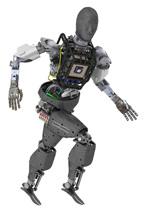December 11, 2012

While we've discussed military and humanoid robots that walk and climb stairs, commenters on our robot stories have speculated what might happen when military humanoid robots start using weapons.
That future may be closer than we think. A humanoid robot that robotics pioneer Boston Dynamics has been developing for DARPA now has arms. This Pet-Proto, based on the company's previous Petman robot, is the one we wrote about when it learned to climb stairs. In a recent DARPA video (watch it below), you can see the Pet-Proto maneuver around and climb over various obstacles similar to what robots will face in the agency's latest Robotics Challenge.

Although the Pet-Proto robot shown in the video is still attached by wires, a rendering of what it will look like in its more advanced incarnation as DARPA's Atlas robot shows an independent, wire-free, more humanoid form.
Text accompanying the video states, "To maneuver over and around the obstacles, the robot exercises capabilities including autonomous decision-making, dismounted mobility and dexterity." A version of this robot shown in the rendering will be provided to DARPA Robotics Challenge teams from Tracks B and C who successfully qualify. Registration for those tracks began in late October.
DARPA's DRC Simulator is currently available in beta version 1.0, and during the next few months, will be improved by the recently formed Open Source Robotics Foundation (OSRF). According to a press release:
Over time, it will be increasingly populated with models of robots, perception sensors, and field environments, and function as a cloud-based, real-time, operator-interactive virtual test bed that uses physics-based models of inertia, actuation, contact, and environment dynamics.
A previous OSRF project, Gazebo, is a 3D multi-robot simulator with dynamics that can accommodate a population of multiple robots, sensors, and objects in a 3D environment.
The Robotics Challenge will test robots' abilities in accomplishing several tasks that simulate a post-disaster environment, with multiple obstacles and dangers to overcome. It's designed to help spur the development of more autonomous robots.
All the descriptions I've seen of the Robotics Challenge, and the robots DARPA is encouraging engineers to develop, emphasize rescue robots, doing things like driving a truck, putting out fires, or carrying wounded people away from fallen buildings. I keep wondering, though, what's to prevent the agency from teaching these autonomous robots, which make their own decisions, to use guns? And would that in any way be a good thing?
Related posts:
About the Author(s)
You May Also Like



